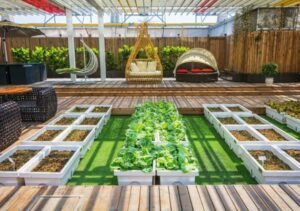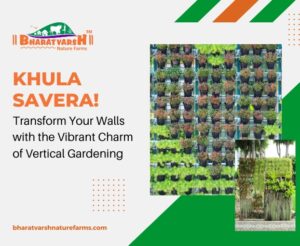Vertical gardening is a delightful fusion of nature and artistry, offering a refreshing way to breathe life into any space. Coupled with the innovative concept of Khula Savera, it presents an unparalleled opportunity to adorn your walls with cascading greenery and vibrant blooms. In this article, we’ll explore the wonders of vertical gardening, from its myriad benefits to practical tips for implementation.
Introduction
Khula Savera, a term derived from Urdu, translates to “open morning.” It symbolizes the dawn of a new era in home decor, where walls become living canvases bursting with vitality. Vertical gardening, the cornerstone of Khula Savera, involves cultivating plants vertically, either on walls or structures, instead of traditional horizontal beds.
Benefits of Vertical Gardening

The allure of vertical gardening lies in its multifaceted benefits:
Space-saving solution:
In bustling urban environments, where space is at a premium, vertical gardens present a savvy solution. They offer a space-efficient alternative, enabling individuals to infuse lush greenery into even the most confined areas.
Improves air quality:
Plants act as natural air purifiers, absorbing pollutants and releasing oxygen, thus contributing to a healthier indoor environment.
Enhances aesthetic appeal:
Vertical gardens serve as striking focal points, transforming mundane walls into vibrant showcases of natural beauty, thereby enhancing the overall aesthetics of any space.
Getting Started with Vertical Gardening
Embarking on a vertical gardening project requires careful planning and execution:
Selecting the right wall:
Choose a sturdy, well-lit wall that receives adequate sunlight and is conducive to plant growth. Consider factors such as structural integrity and proximity to water sources.
Choosing suitable plants:
Opt for plants that thrive in vertical environments, such as trailing vines, ferns, succulents, and herbs. Ensure compatibility in terms of light and water requirements.
Essential tools and materials:
Gather necessary supplies, including planters or pockets, soil mix, irrigation systems, and mounting hardware. Invest in high-quality materials to ensure longevity and stability.
Installation Process
Follow these steps to bring your vertical garden to life:
Preparing the wall surface:
Clean the wall surface thoroughly to remove dirt, dust, and debris. Repair any cracks or imperfections, and apply a waterproof sealant if necessary to protect the wall.
Installing support structures:
Install support structures such as trellises, grids, or modular panels to provide a framework for your plants. Ensure proper anchoring to the wall to support the weight of the garden.
Planting and watering techniques:
Carefully plant your chosen vegetation in the designated pockets or containers, ensuring proper spacing and depth. Establish a regular watering schedule to keep the plants adequately hydrated.

Maintenance Tips
Sustain the beauty of your vertical garden with these maintenance guidelines:
Regular watering and fertilization:
Monitor soil moisture levels and water the plants as needed, taking care not to overwater. Supplement with organic fertilizers to provide essential nutrients for healthy growth.
Pruning and pest control:
Trim overgrown foliage and remove any dead or diseased plants to promote air circulation and prevent pest infestations. Implement natural pest control methods to deter unwanted insects.
Monitoring plant health:
Keep a watchful eye on the overall health of your vertical garden, checking for signs of stress, nutrient deficiencies, or pest damage. Promptly address any issues to maintain plant vitality.
Creative Ideas for Vertical Gardens
Let your imagination soar with these innovative vertical gardening concepts:
Herb walls for culinary enthusiasts:
Create a vertical herb garden with aromatic herbs like basil, rosemary, and mint, providing fresh ingredients for culinary delights right at your fingertips.
Succulent gardens for low maintenance:
Design a succulent wall featuring an array of drought-tolerant succulent species, adding texture and color to indoor or outdoor spaces with minimal upkeep.
Flower walls for vibrant displays:
Craft a floral masterpiece with a vertical flower garden showcasing seasonal blooms, offering a kaleidoscope of colors and fragrances to uplift the senses.
Vertical Gardening in Urban Settings
Vertical gardening transcends physical boundaries, offering a green oasis in bustling urban landscapes:
Overcoming space constraints:
Vertical gardens enable urban dwellers to embrace nature despite space limitations, fostering a deeper connection with the environment within the confines of city living.
Bringing nature into urban environments:
By incorporating vertical gardens into urban architecture and public spaces, cities can mitigate the adverse effects of urbanization and promote biodiversity conservation.
Community engagement through vertical gardens:
Vertical gardening initiatives have the potential to unite communities, fostering collaboration and shared stewardship of green spaces for the benefit of all residents.
Environmental Impact
The ecological significance of vertical gardening extends far beyond aesthetic appeal:
Carbon footprint reduction:
Vertical gardens sequester carbon dioxide, mitigating climate change by offsetting carbon emissions and promoting carbon neutrality in urban areas.
Biodiversity support:
By providing habitat and food sources for birds, insects, and other wildlife, vertical gardens contribute to urban biodiversity conservation and ecosystem resilience.
Contribution to green initiatives:
Vertical gardening aligns with sustainable development goals, offering a green solution to urban greening, food security, and resource conservation challenges.
Cost Considerations
While the initial investment in vertical gardening may seem daunting, the long-term benefits outweigh the costs:
Initial investment vs. long-term savings:
While the upfront costs of materials and installation may be significant, the savings in water bills, energy consumption, and maintenance expenses over time make vertical gardening a worthwhile investment.
DIY vs. professional installation:
Consider your budget, time constraints, and level of expertise when deciding between DIY installation and hiring professional landscapers. DIY projects offer cost savings but require careful planning and execution.
Success Stories
Numerous individuals and businesses have embraced the transformative power of vertical gardening:
Challenges and Solutions
Despite its myriad benefits, vertical gardening poses certain challenges:
Dealing with limited sunlight:
In areas with limited sunlight such as shady or north-facing locations, choosing shade-tolerant plants and integrating supplementary lighting can compensate for sunlight deficiencies, fostering robust and healthy plant growth.
Addressing structural concerns:
Prioritize adequate wall reinforcement and strategic weight distribution to safeguard against structural damage or instability. Seek guidance from structural engineers or gardening experts to ensure expert advice tailored to your specific needs and circumstances.
Future Trends
The future of vertical gardening holds exciting possibilities:
Advancements in vertical gardening technology:
Expect to see innovations such as modular systems, automated irrigation, and vertical hydroponics revolutionizing the way we design and maintain vertical gardens.
Integration with smart home systems:
Imagine a future where vertical gardens are seamlessly integrated into smart home ecosystems, allowing for remote monitoring, automated care, and personalized plant maintenance.
On a final Note:
In conclusion, Khula Savera offers a transformative journey into the realm of vertical gardening, where walls become vibrant tapestries of greenery and blooms. Bharatvarsh Nature Farms invites you on a transformative journey into the world of vertical gardening, where walls blossom into vibrant tapestries of greenery. By embracing this innovative concept, individuals can not only enhance the beauty of their surroundings but also contribute to a greener, more sustainable future for generations to come.
Also Read: Homegrown Happiness: 10 Tips for Cultivating Your Perfect Vegetable Garden
FAQs
Q: How much sunlight do vertical gardens need?
A: Most vertical gardens require at least 6 hours of sunlight per day, but there are shade-tolerant plants suitable for low-light environments.
Q: Can I create a vertical garden indoors?
A: Yes, vertical gardens can thrive indoors with proper lighting, ventilation, and irrigation systems.
Q: Are vertical gardens difficult to maintain?
A: With regular care and attention to watering, fertilizing, and pruning, vertical gardens can be relatively low maintenance.
Q: Can I install a vertical garden myself?
A: DIY vertical gardening projects are feasible with proper planning and execution, but professional installation may be preferable for complex designs or structural concerns.
Q: What are the environmental benefits of vertical gardening?
A: Vertical gardening helps improve air quality, reduce urban heat island effects, conserve water, and support biodiversity in urban environments.
>>> Contact us today for any queries!




